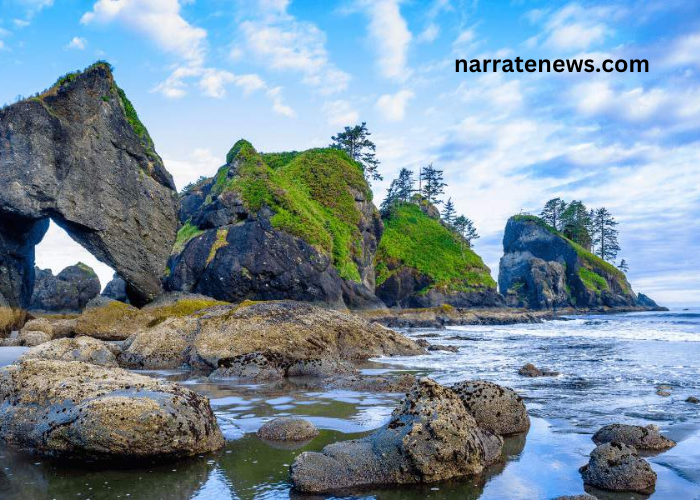
Top 10 World Heritage Sites in the USA
The United States, a nation celebrated for its vast landscapes, rich history, and diverse cultures, is home to a collection of UNESCO World Heritage Sites that stand as cultural and natural treasures. These sites, recognized for their outstanding universal value, contribute to the global tapestry of human history, ecological diversity, and architectural brilliance. In this in-depth exploration, we will embark on a journey to discover the top 10 UNESCO World Heritage Sites in the United States, each offering a unique glimpse into the nation’s heritage and the wonders of our planet.
Top 10 World Heritage Sites in the USA
1. Statue of Liberty (1984)
Dominating the entrance to New York Harbor, the Statue of Liberty is an iconic symbol of freedom and democracy. Gifted by France to the United States in 1886, Lady Liberty stands tall, welcoming immigrants arriving by sea. Designated as a UNESCO World Heritage Site in 1984, the statue is not only a national emblem but a global beacon of hope and a testament to the enduring ideals of liberty and equality.
The Statue of Liberty National Monument encompasses Liberty Island and the statue itself, allowing visitors to experience the historical significance of this monument. From the pedestal observation deck, one can marvel at panoramic views of New York Harbor and reflect on the millions of immigrants who sought a new life in the United States.
2. Yellowstone National Park (1978)
Designated as the first national park in the world in 1872, Yellowstone National Park was later recognized as a UNESCO World Heritage Site in 1978. Spanning three states—Wyoming, Montana, and Idaho—Yellowstone is a geothermal wonderland, home to iconic features like Old Faithful, colorful hot springs, and diverse wildlife.
Yellowstone’s World Heritage designation acknowledges its unparalleled geothermal activity, unique geological features, and critical role in the conservation of globally significant ecosystems. Visitors to Yellowstone have the opportunity to witness the raw power of nature, from erupting geysers to roaming herds of bison, making it a destination that captures the essence of America’s natural beauty.
3. Grand Canyon National Park (1979)
Carved by the relentless forces of the Colorado River over millions of years, the Grand Canyon is one of the most awe-inspiring natural wonders on the planet. Designated a UNESCO World Heritage Site in 1979, the Grand Canyon National Park in Arizona attracts millions of visitors annually, eager to witness the sheer magnitude and breathtaking beauty of this colossal chasm.
The Grand Canyon’s World Heritage status underscores its geological significance and the intricate rock formations that reveal the Earth’s geological history. Visitors can explore the rim, hike into the canyon, or embark on a river rafting adventure to fully appreciate the scale and grandeur of this iconic landscape.
4. Independence Hall (1979)
Located in the heart of Philadelphia, Independence Hall is a UNESCO World Heritage Site that played a pivotal role in the founding of the United States. This historic building witnessed the signing of both the Declaration of Independence in 1776 and the United States Constitution in 1787. The principles enshrined in these documents laid the groundwork for the democratic ideals that shape the nation today.
Designated as a World Heritage Site in 1979, Independence Hall is part of Independence National Historical Park, where visitors can explore not only the hall itself but also the Liberty Bell and other significant historical landmarks. The site offers a poignant journey through America’s quest for independence and the establishment of a democratic government.
5. Monticello and the University of Virginia in Charlottesville (1987)
The architectural and intellectual legacy of Thomas Jefferson is immortalized in Monticello and the University of Virginia in Charlottesville. Both sites, designated as a UNESCO World Heritage Site in 1987, reflect Jefferson’s contributions to American architecture, education, and the ideals of the young nation.
Monticello, Jefferson’s plantation home, is a masterpiece of neoclassical design. Visitors can explore the meticulously designed gardens, the iconic dome room, and the intimate spaces where Jefferson pursued his intellectual endeavors. The University of Virginia, founded by Jefferson, showcases his vision for an academically centered community with its historic Lawn and Rotunda.
6. Redwood National and State Parks (1980)
On the rugged northern California coastline, the Redwood National and State Parks form a UNESCO World Heritage Site that preserves ancient redwood forests. These towering giants, including the world’s tallest tree, the Hyperion, provide a sanctuary for diverse flora and fauna. Designated in 1980, this site celebrates the ecological importance of redwood ecosystems and the need to protect these ancient trees.
Visitors to the Redwood National and State Parks can marvel at the towering trees along scenic drives, hike through lush forests, and explore pristine coastal landscapes. The World Heritage designation recognizes the significance of these ancient redwoods in maintaining biodiversity and fostering environmental resilience.
7. Everglades National Park (1979)
Florida’s unique Everglades, a vast wetland ecosystem, earned its designation as a UNESCO World Heritage Site in 1979. The park’s intricate network of mangroves, sawgrass marshes, and freshwater sloughs provides a crucial habitat for a diverse array of wildlife, including alligators, manatees, and numerous bird species.
Designated for its outstanding ecological importance, Everglades National Park offers visitors a chance to explore this unique environment through airboat tours, wildlife viewing, and hiking trails. The park’s World Heritage status emphasizes the need to protect this delicate ecosystem and its critical role in maintaining water quality and supporting diverse wildlife populations.
8. Mesa Verde National Park (1978)
Nestled in the canyons of southwestern Colorado, Mesa Verde National Park is a UNESCO World Heritage Site that preserves the archaeological heritage of the Ancestral Puebloan people. Designated in 1978, the park is renowned for its well-preserved cliff dwellings, showcasing the architectural ingenuity of the ancient inhabitants who thrived in the region for centuries.
Visitors to Mesa Verde can explore the cliff dwellings, kivas, and petroglyphs that provide insights into the daily lives and cultural practices of the Ancestral Puebloans. The World Heritage designation underscores the importance of preserving these cultural treasures and understanding the complex history of Native American civilizations.
9. Great Smoky Mountains National Park (1983)
Straddling the border between North Carolina and Tennessee, the Great Smoky Mountains National Park is a UNESCO World Heritage Site and a biodiversity hotspot. Designated in 1983, the park is home to a rich variety of plant and animal life, including synchronous fireflies that light up the forest during their mating season.
Visitors to the Great Smokies can experience the diverse ecosystems through scenic drives, hiking trails, and wildlife observation. The park’s World Heritage status highlights its ecological significance and the need for conservation efforts to protect its unique flora and fauna.
10. Pueblo de Taos (1992)
Nestled in the high desert of New Mexico, Pueblo de Taos is a UNESCO World Heritage Site that embodies the living traditions of the Taos Pueblo people. Designated in 1992, this site features multi-storied adobe dwellings, some dating back over a thousand years, showcasing the architectural and cultural resilience of this Native American community.
Visitors to Pueblo de Taos can explore the pueblo’s narrow alleys, visit the historic San Geronimo Church, and experience the cultural traditions of the Taos Pueblo people. The World Heritage designation recognizes the importance of preserving these living cultural landscapes and the enduring connection between the Taos Pueblo people and their ancestral lands.
Preservation Challenges and Conservation Efforts
While these UNESCO World Heritage Sites in the United States are celebrated for their cultural and natural significance, many face ongoing challenges that threaten their integrity. These challenges include climate change, habitat degradation, urbanization, and the impact of tourism. Conservation efforts, often led by dedicated park authorities, local communities, and international organizations, aim to strike a delicate balance between preserving the sites and making them accessible to the public.
Climate Change Impacts:
Climate change poses a significant threat to several World Heritage Sites. Rising temperatures, altered precipitation patterns, and extreme weather events can affect ecosystems, endanger species, and accelerate the deterioration of cultural monuments. Adaptive measures and sustainable practices are crucial for mitigating these impacts.
Tourism Management:
The popularity of UNESCO World Heritage Sites attracts millions of visitors each year, contributing to the local economies but also presenting challenges in terms of site management. Sustainable tourism practices, visitor education, and controlled access are essential components of preserving the sites for future generations.
Cultural Heritage Conservation:
Many cultural heritage sites face threats from urbanization, inadequate infrastructure, and even conflicts. Preservation efforts involve meticulous conservation practices, community engagement, and international collaboration to ensure the protection of these sites and their intrinsic values.
Biodiversity Conservation:
UNESCO World Heritage Sites that are designated for their natural values, such as Yellowstone National Park and the Great Smoky Mountains, require vigilant efforts to safeguard biodiversity. Conservation initiatives include habitat restoration, species protection, and scientific research to monitor and manage ecosystems.
Collaborative Initiatives:
The collaborative efforts of governments, local communities, non-governmental organizations, and international bodies are critical for the sustained preservation of World Heritage Sites. Partnerships facilitate the sharing of resources, expertise, and best practices to address complex challenges.
Conclusion: Guardians of Heritage and Nature
The UNESCO World Heritage Sites in the United States are not mere historical relics or natural wonders—they are living testaments to the intricate tapestry of human civilization and the wonders of the natural world. These sites invite us to explore, appreciate, and reflect on the cultural and ecological treasures that define our nation.
As we traverse the hallowed halls of Independence Hall, stand in awe at the rim of the Grand Canyon, and marvel at the towering redwoods, we are reminded of the responsibility we bear as stewards of our heritage. The UNESCO World Heritage designation is not just an accolade; it is a call to action. It urges us to protect, preserve, and cherish these sites for future generations.
The stories etched in the landscapes and structures of these sites beckon us to tread lightly, to learn from the past, and to envision a future where the wonders of our world endure for generations to come. The top 10 UNESCO World Heritage Sites in the United States are not just destinations—they are the crown jewels of our shared heritage, waiting to be explored, admired, and safeguarded for the flourishing of our cultural and natural legacy.


